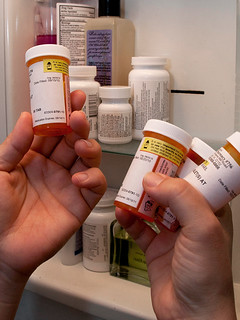Every instance of drug use is also a transaction between the users and the suppliers, whether the supplier is a dealer, a friend trying to be helpful or a parent that leaves prescription pills in easy reach. On the user side of the transaction the decision to partake always meets some need or desire on the part of the user. How strong the need or desire to take a drug is a variable, and therefore potentially controllable. It is important to understand what needs are being met when a young person decides to partake in drugs or alcohol. The lists below are among some frequent motivators that lead to drug transaction and drug use. Each of these factors can be modulated by family or community interventions. Still, this is just one side of the transaction.

Dangerously addictive prescription drugs in the home are often a gateway to teenage drug addiction.
(Image by The U.S. Food and Drug Administration) Details DMCA
On the other side of the equation is the availability and cost of the product being consumed and the economic pressures on the supply side of the equation. Just like any transaction, the lower the price or availability of the product the more likely a transaction will occur. Factors affecting price and availability include not just law-enforcement interdiction but market factors in the legal and illegal drug trade, the strength of a profit motive for individual dealers, the pain-management and prescribing practices of doctors, the economic pressures of small business owners selling cigarettes or alcohol to minors, the amount of peer pressure being applied to sell or give drugs to others, the vigilance of parents in keeping products in the home out of the reach of their children, etc.
Primary prevention is all the things we can do as families and a society to forestall or eliminate an individual's preliminary exposure to addictive substances. It is the efforts undertaken to eliminate the various needs (or demands) that initiate drug transactions in the first place.
The following is a collection of ideas on the topic from a variety of sources with the URL links to some of the material and my own thoughts provided in the bracketed text. My purpose is to initiate or support public dialogue about what can be done to fix our drug problems. Let me begin with some ideas as to why children try drugs in the first place.
Here are some of the reasons young people have given for taking drugs :
To fit in
[The need to belong and feel accepted and valued is a powerful and universal human need that is denied to children who are marginalized, bullied or made to feel incompetent in their social environment. This leads youth to seek acceptance in alternative and sometimes more socially maladaptive peer groups where they are more at risk for substance abuse. Making sure our youth feel connected, engaged and valued within their families and the community is a protective factor that reduces the risk of substance abuse. Anti-bullying efforts in schools, identifying and intervening children who are being marginalized by their peers and teaching teachers how to be more effective manages the social milieu in their classrooms are other step that should be taken.]
To escape or relax
[The ever-growing competitive trends in education and youth sports programs has placed unprecedented pressure on today's youth beginning at an early age. This places youth at ever-increasing risk of turning to drugs to relieve their stress. Little-league sports programs once focused on the social development that helped children learn how to work together and support each other as a team. Today there are increasing focuses on developing the individual talents of star players and on winning as the major objectives. We may need to rethink our whole approach to both academic achievements and youth-sports programs. A protective factor in preventing substance abuse might be to find ways to reduce the stress we place on children in school and in organized sports.]
To relieve boredom
[Students whose parents work and who are not in some after-school programs come home to an empty house. Some researchers say that the most at-risk time for children to abuse substances is this after-school period before parents come home from work. Younger children especially need guidance and leadership in structuring their recreational activity. Children also need appropriate socialization opportunities. Unstructured leisure time leads to increases in time spent on passive entertainment such as watching TV or in playing video games or in engaging in online activities such as chat rooms. These can lead to lethargy and depression as well as boredom. It places kids at greater risk of substance use to relieve boredom and depression. An alternative would be after-school efforts to help children identify and develop their interests and skills other than traditional sports activities. We need a strength-based approach to helping children develop skills in dance, acting, music, art, debate, chess, and other such alternative activities.]
To seem grown up
[There are several aspects to this one. First, parents are primary role models in younger children. What parents do helps define what seems normal for adult behavior. If parents smoke, drink and use drugs this greatly increases the likelihood that their children we try these activities as part of their social development. Then there is the aspect of a child's exposure to the social behavior of older cohorts in the family, schools or the community. To the extent that substance abuse becomes a community-wide problem the younger cohorts will see the substance use by older youth as grown-up behaviors. Then there is the impact of media depiction of drugs on television and in the movies. Parental monitoring and the exercise of discretion in what shows children watch has an impact on a child's future behavior is an example of a protective strategy to lower the risk of future abuse.]
To rebel
(Note: You can view every article as one long page if you sign up as an Advocate Member, or higher).





